
Deep Learning with PyTorch Quick Start Guide
Learn to train and deploy neural network models in Python
David Julian
- 158 Seiten
- English
- ePUB (handyfreundlich)
- Über iOS und Android verfügbar
Deep Learning with PyTorch Quick Start Guide
Learn to train and deploy neural network models in Python
David Julian
Über dieses Buch
Introduction to deep learning and PyTorch by building a convolutional neural network and recurrent neural network for real-world use cases such as image classification, transfer learning, and natural language processing.
Key Features
- Clear and concise explanations
- Gives important insights into deep learning models
- Practical demonstration of key concepts
Book Description
PyTorch is extremely powerful and yet easy to learn. It provides advanced features, such as supporting multiprocessor, distributed, and parallel computation. This book is an excellent entry point for those wanting to explore deep learning with PyTorch to harness its power.
This book will introduce you to the PyTorch deep learning library and teach you how to train deep learning models without any hassle. We will set up the deep learning environment using PyTorch, and then train and deploy different types of deep learning models, such as CNN, RNN, and autoencoders.
You will learn how to optimize models by tuning hyperparameters and how to use PyTorch in multiprocessor and distributed environments. We will discuss long short-term memory network (LSTMs) and build a language model to predict text.
By the end of this book, you will be familiar with PyTorch's capabilities and be able to utilize the library to train your neural networks with relative ease.
What you will learn
- Set up the deep learning environment using the PyTorch library
- Learn to build a deep learning model for image classification
- Use a convolutional neural network for transfer learning
- Understand to use PyTorch for natural language processing
- Use a recurrent neural network to classify text
- Understand how to optimize PyTorch in multiprocessor and distributed environments
- Train, optimize, and deploy your neural networks for maximum accuracy and performance
- Learn to deploy production-ready models
Who this book is for
Developers and Data Scientist familiar with Machine Learning but new to deep learning, or existing practitioners of deep learning who would like to use PyTorch to train their deep learning models will find this book to be useful. Having knowledge of Python programming will be an added advantage, while previous exposure to PyTorch is not needed.
Häufig gestellte Fragen
Information
Deep Learning Fundamentals
- Approaches to machine learning
- Learning tasks
- Features
- Models
- Artificial neural networks
Approaches to machine learning


- Whether or not models are trained with labelled training data. There are several possibilities here, including entirely supervised, semi-supervised, based on reinforcement, or entirely unsupervised.
- Whether they are online (that is, learning on the fly as new data is presented), or learn using pre-existing data. This is referred to as batch learning.
- Whether they are instance-based, simply comparing new data to known data, or model-based, involving the detection of patterns and building a predictive model.
Learning tasks
- Unsupervised learning: Data is unlabeled so the algorithm must infer a relationship between variables or by finding clusters of similar variables
- Supervised learning: Uses a labeled dataset to build an inferred function that can be used to predict the label of an unlabeled sample
Unsupervised learning
Clustering
Inhaltsverzeichnis
- Title Page
- Copyright and Credits
- About Packt
- Contributors
- Preface
- Introduction to PyTorch
- Deep Learning Fundamentals
- Computational Graphs and Linear Models
- Convolutional Networks
- Other NN Architectures
- Getting the Most out of PyTorch
- Other Books You May Enjoy